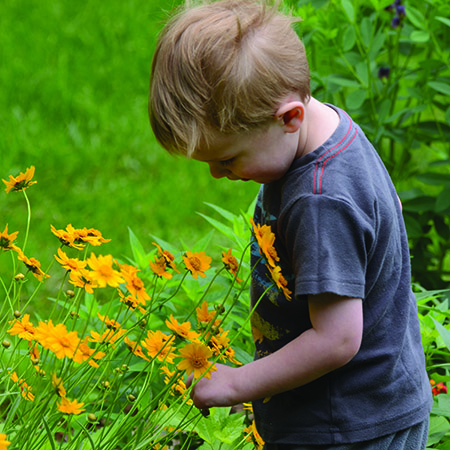Why Choose Native Plants?
Because What You Plant Matters….
We must find ways to design landscapes that enhance rather than degrade the ecosystems around us.
-Doug Tallamy

For Wildlife and Food Supply
Native plants are foundational in ecosystems. Through photosynthesis, they convert energy from the sun into forms that are usable for all other living things. Native plants provide nectar, shelter, and sustenance for butterflies, pollinators, and birds.
You are probably familiar with the iconic Monarch butterfly, whose caterpillars can only eat milkweeds. This relationship is not unique in the insect kingdom. Over millennia, native insects and butterflies have co-evolved with the plants that provide for them. Many species eat and reproduce only on specific plants – native plants.
Caterpillars and other insects not only provide the next generation of butterflies and beetles, they are the perfect food to grow the next generation of birds! Most birds feed their young insects, and caterpillars are a critical source of protein. It takes 6,000 to 9,000 caterpillars to raise a single nest of black capped chickadees! (Source)
Pollinators also depend on native plants for nectar and sustenance, and we humans depend on pollinators – one out of every three bites of food we eat is the result of insect pollination!
Despite all this, most residents, parks, and businesses rely mainly on non-native species, which do not provide much if any wildlife benefit.
For Flood Mitigation, Clean Water and Air
Native Plants manage water flow with their strong root networks. Their deep roots slow down the flow of water, preventing soil erosion and reducing stormwater runoff. Once established, native plants thrive without the use of irrigation, but they’re also regenerative. Native plants and rain gardens help clean water naturally because their deep root systems act as filters for the dirty runoff from streets, parking lots and rooftops.
Native plants take carbon dioxide out of the atmosphere, and their deep roots put it back in the ground (where it belongs!) in a process called carbon sequestration (also called carbon capture or carbon trapping). As plants respire, they absorb carbon dioxide from the air and release oxygen back into it. The carbon dioxide is broken down by plants, depositing carbon into the soil and releasing oxygen into the air. This carbon cycle creates oxygen for us to breathe, but it also puts carbon where it belongs – back into the soil!


For Human Mental and Physical Health
Over and over, studies show that time spent with nature helps us decompress, lowers our stress levels, makes us happier and healthier. Native plants “bring nature home” along with all of its wellness benefits.
Native plants promote higher levels of creativity “. . . a 50 percent improvement in creativity after just a few days in nature.”1
Native plants aid in crime reduction. Buildings in Chicago with the most green views saw 48 percent fewer property crimes and 56 percent fewer violent crimes.”2
Native plants promote better mental health “The good news for city dwellers is that just fifteen to forty-five minutes in a city park, even one with pavement, crowds and some street noise, were enough to improve mood, vitality and feelings of restoration.”3
Native plants create improvements to human physical health. A recent study in Toronto showed the higher a neighborhood’s tree density, the lower the incidence of heart and metabolic disease.4
Williams, Florence. The Nature Fix: Why Nature Makes Us Happier, Healthier, and More Creative. W.W. Norton & Company, 2018, 1page 37, 2page 110, 3page 140, 4page 251.
For Future Generations
In our culture today, young people don’t spend much time in nature. Native plants, teeming with butterflies and caterpillars, can capture a child’s imagination and provide them with opportunities for inquiry, discovery, creativity, and more. Children who spend time in and feel connected to nature tend to become adults who are more inclined to care about the natural world.
For Beauty
Over the years, people have associated native plants with native prairies and other beautiful, rugged, untamed places. Native landscapes at home don’t have to look wild and wooly unless you want them to. With good design and maintenance, native plants can also thrive in traditional gardenscapes.
In the end we will conserve only what we love; we will love only what we understand; and we will understand only what we are taught.
— Baba Dioum
